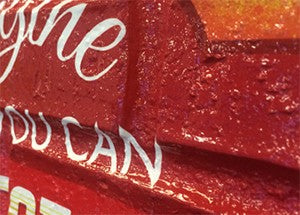A search of our blog using the term “wall graphics” reveals seven previous articles about this topic. We've covered the basics of how to successfully apply vinyl graphics to interior painted walls. If you've read these, you probably know almost everything you need to know about installing wall words (If not, you can get a good start here). What don’t you know that can help your success rate? If you’re using a Vinyl Cutter and matte vinyl, we have vital information about what kinds of paints to avoid for best adhesion and clean removal. If you’re a digital printer, read on to see how to install paint-like prints on challenging surfaces like brick, concrete block walls, even stucco. Consider these advanced techniques for wall graphics for plotter and printers.
Advanced tips for plotters & wall words
Most failures with vinyl graphics on painted walls have nothing to do with the vinyl. The “X factor” that often determines success or failure is the paint. According to Amy Swaille, MACtac’s Associate Marketing Manager for Training and Communications, two problems cause paint problems: too new and too good.Too new: By far, the most common reason for failure in applied wall words is application on freshly painted surfaces. Just because it’s dry to the touch doesn’t mean it’s ready for your vinyl graphics. Like solvent inkjet prints, most paint used for interior walls includes VOCs (Volatile organic compounds) that evaporate or “outgas” over time. If you apply vinyl over uncured paint, the VOCs trapped under the vinyl begin to chemically interact with the adhesive. This usually results in a rapid degradation of the adhesive leading to failure. It literally falls off the wall!
However, the opposite problem can also occur. The solvents can chemically bond with the adhesive and fuse the vinyl to the wall so that it is no longer removable. That failure won’t be clear until the end-user decides to remove and replace the graphic, at which time they’ll also remove a big chunk of paint and probably replace you on their list of trusted installers. How do you avoid these problems? Simply give fresh paint adequate time to cure before decorating with vinyl. Two weeks are the recommended wait time.
Too good: What if you’ve allowed proper time for the paint to cure and your vinyl graphic still won’t stay stuck? Is the paint “good”? In other words, too fancy? High end interior paints like the Glidden Premium Collection have additives designed to make them stain resistant and easy to clean. Unfortunately, those stain resistant additives are also adhesive resistant and can defeat successful application of vinyl graphics.
If your vinyl won’t stick, get more information about what’s in the paint. If you can, take the time and recommend to your customer about what paint to use, especially in a new commercial venture. Tell them to look for a good, basic satin finish latex. Matte finish paints can have a chalky residue that acts like a perpetual layer of dust that undermines adhesion.
Advanced Tips for Printed Wall Graphics
You’ve probably seen these at trade shows. Wall wraps are the newest trend in commercial architectural graphics. They’re very engaging and effective marketing tools, especially for outdoor venues like schools and sporting arenas. Grand format wall wraps are also gaining acceptance as a more sustainable alternative to mesh banner on buildings because you don’t have to perforate the outer walls with mounting hardware to anchor the scrim. Just print it, apply it, then remove it cleanly. Having the graphic applied directly to the brick or block exterior wall also eliminates the possibility that the print will blow off the building. So you don’t need to degrade the design with wind slits that can disrupt the image or perforation or reduces color saturation.
Better image quality naturally means a more effective message for the advertiser. So adhesive vinyl preserves exterior wall integrity and allows for better image quality. Everybody wins (with the possible exception of the mesh banner manufacturers).
So how do you make this work? You start with the right print media, then make sure you apply it correctly. Here’s how. There are a few options in this category including 3M IJ8624, and ORACAL'S new ORAJET 3954 Brick Stone Film. Most vinyls for this category require use of an Overlaminate Film. The film gives the vinyl a little more body which may not be ideal for working it into challenging textures, but it also simplifies removal. Trying to remove an un-laminated premium wall vinyl from concrete or stucco will be a tedious process as the film will most likely come off in pieces. The recommended overlaminate for ORAJET 3954 is ORAGUARD 290 or 290F. For more tips on printed and plotter-cut wall graphics applications, check out our archived "Writing On The Wall" webinar on SIGNWarehouse Television. Whether you’re working with vinyl cutters and matte vinyl or a large format digital printer and 3954, architectural graphics represent dynamic new markets for your products. Conquering the challenges of wall words and outdoor print applications can bring substantial gains in sales. Making sure you know what kind of paint you’re covering, how long it’s been out of the can, and how to make your printed vinyl perform at its best are the keys to maximizing this profitable new market.



































